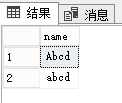SqlApi里面的executeQuery(),executeUpdate(),execute()的使用
- 作者: 深花瓣
- 来源: 51数据库
- 2021-09-30
SqlApi里面的executeQuery(),executeUpdate(),execute()的使用
Statement提供了三种执行SQL语句的方法:executeQuery、executeUpdate和 execute。使用哪一个方法由 SQL 语句所产生的内容决定。
一、方法executeQuery()用户产生单个结果集的语句,使用最多的的执行SQL语句方法是executeQuery,这个方法用来执行select语句
public static selectSql(){
Connection connection=null;
PreparedStatement preparedStatement=null;
Result SetresultSet = null;
String className=”com.microsoft.sqlserver.jdbc.SQLServerDriver”;
String url=”jdbc:sqlserver://localhost:1433;databaseName=Test”;
String user=”sa”;
String password=”123”;
try {
connection=DriverManager.getConnection(url,user, password);
Class.forName(className);
Stringsql=”select * from Test_table”;
preparedStatement=connection.prepareStatement(sql);
resultSet=preparedStatement.executeQuery();
while (resultSet.next()) {
System.out.println(resultSet.getString(“name”));
}
}catch(SQLException e) {
// TODO Auto-generated catch block
e.printStackTrace();
}catch(ClassNotFoundException e) {
// TODO Auto-generated catch block
e.printStackTrace();
}finally{
try {
if (resultSet!=null) {
resultSet.close();
}
if (preparedStatement!=null) {
preparedStatement.close();
}
if (connection!=null) {
connection.close();
}
}catch(SQLException e) {
// TODO Auto-generated catch block
e.printStackTrace();
}
}
}
二、方法executeUpdate()用于执行insert,delete,update等SQL语句,executeupdate返回的值是一个整数,表示受影响的行数,对于create table等不操作行的语句,executeupdate的返回值为0, 下面示例是将“张三”的名字改为“张三1”:
public staic updateSql(){
Connection connection=null;
PreparedStatement preparedStatement=null;
String className=”com.microsoft.sqlserver.jdbc.SQLServerDriver”;
String url=”jdbc:sqlserver://localhost:1433;databaseName=Test”;
String user=”sa”;
String password=”123”;
try {
connection=DriverManager.getConnection(url,user,password);
Class.forName(className);
Stringsql=”update Test_table set name=’张三1’ where name=’张三’”;
preparedStatement=connection.prepareStatement(sql);
if(preparedStatement.executeUpdate()>0) {
System.out.println(“更新成功”);
}else{
System.out.println(“更新失败”);
}
}catch(SQLException e) {
// TODO Auto-generated catch block
e.printStackTrace();
}catch(ClassNotFoundException e) {
// TODO Auto-generated catch block
e.printStackTrace();
}finally{
try {
if (preparedStatement!=null) {
preparedStatement.close();
}
if (connection!=null) {
connection.close();
}
}catch(SQLException e) {
// TODO Auto-generated catch block
e.printStackTrace();
}
}
三、execute()方法
execute方法应该仅在语句能返回多个ResultSet对象、多个更新计数或ResultSet对象与更新计数的组合时使用。
其返回值为布尔类型:是true时,表示执行的是查询语句,可以通过getResultset方法获取结果;返回值为false时,执行的是更新语句或DDL语句,getUpdateCount方法获取更新的记录数量
execute()方法处理的是较复杂的SQL语句或结果。
当某个过程返回两个结果集,则在使用方法 execute 执行该过程后,必须调用方法getResultSet()获得第一个结果集,然后调用适当的getXXX方法获取其中的值。要获得第二个结果集,需要先调用getMoreResults()方法,然后再调用getResultSet方法。
当某个过程返回两个更新计数,则首先调用方法getUpdateCount(),然后调用getMoreResults(),并再次调用getUpdateCount()。
对于不知道返回内容,则情况更为复杂。如果结果是ResultSet对象,则方法execute 返回 true;如果结果是 Java int,则返回 false。如果返回int,则意味着结果是更新计数或执行的语句是 DDL 命令。在调用方法 execute 之后要做的第一件事情是调用getResultSet或getUpdateCount。调用方法getResultSet可以获得两个或多个ResultSet对象中第一个对象;或调用方法getUpdateCount可以获得两个或多个更新计数中第一个更新计数的内容。
例:
public static updateSql1(){
Connection connection = null;
PreparedStatement preparedStatement = null;
String className = “com.microsoft.sqlserver.jdbc.SQLServerDriver”;
String url = “jdbc:sqlserver://localhost:1433;databaseName=Test”;
String user = “sa”;
String password = “123”;
try {
//select id from Test_table
connection= DriverManager.getConnection(url, user, password);
Class.forName(className);
Stringsql = “select id from Test_table”;
preparedStatement= connection.prepareStatement(sql);
if(preparedStatement.execute()) {
System.out.println(“获取的结果集是”);
ResultSetresultSet=preparedStatement.getResultSet();
while (resultSet.next()) {
System.out.println(resultSet.getString(“id”));
}
}else {
System.out.println(“更新的结果是:”+preparedStatement.getUpdateCount());
}
}catch(SQLException e) {
// TODO Auto-generated catch block
e.printStackTrace();
}catch(ClassNotFoundException e) {
// TODO Auto-generated catch block
e.printStackTrace();
}finally{
try {
if (preparedStatement != null) {
preparedStatement.close();
}
if (connection != null) {
connection.close();
}
}catch(SQLException e) {
// TODO Auto-generated catch block
e.printStackTrace();
}
}
}
- SQLite数据库操作:原生操作,GreenDao操作讲解
- 数据库SQL实战题:获取员工其当前的薪水比其manager当前薪水还高的相关信息(教程)
- SQLSERVER查询区分大小写的写法分析
- SQL学习总结之SQL的分类介绍
- 阶梯到高级T-SQL 1级:高级T-SQL介绍交叉连接
- 高级T-SQL级别1的Stairway:使用CROSS JOIN引入高级T-SQL分析
- 什么是SQL隔离级别?四个SQL隔离级别定义介绍
- Sql递归介绍之用with实现递归查询
- SQLSERVER查询时日期格式化的实例讲解
- 数据库SQL实战:从titles表获取按照title进行分组,注意对于重复的emp_no进行忽略(题解)











